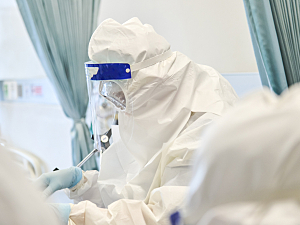For clinicians who can’t wear a traditional N95 respirator mask during the COVID-19 pandemic, an option recommended by the CDC is a powered air-purifying respirator (PAPR), which propels air through filters into a fitted hood. According to one manufacturer, active filtration with a PAPR produces ambient noise of approximately 74 dB within the hood—slightly louder than a vacuum cleaner.
Emily J. Moldoff, MS, FNP-C, a family nurse practitioner in the Division of Otolaryngology—Head and Neck Surgery at Brigham and Women’s Hospital, Carleton Eduardo Corrales, MD, a surgeon in the division, Jennifer J. Shin, MD, an otolaryngologic surgeon and vice-chair of Faculty Development in the Department of Surgery, and colleagues have documented that PAPRs create a substantial barrier to communication during clinical interactions and present sound at levels which could be associated with acoustic trauma in those wearing the PAPRs over prolonged time periods.
Their report appears in Otolaryngology—Head and Neck Surgery.
Methods
The research team administered sound field testing to five adult health care providers who had normal hearing and otologic histories. The testing had two parts:
- Word recognition—measured without the PAPR (baseline) at a word presentation volume of 55 dB (considered typical for speech) and with active PAPR use at 55, 80, 85 and 90 dB
- Pure tone thresholds—measured at baseline and with active PAPR use at 250, 500, 1000, 2000, 4000 and 8000 Hz
Word Recognition
A score of 92% (the percentage of correctly identified words according to standard prerecorded speech audiometry) was prespecified as a level that supports successful communication during word recognition testing:
- At baseline, all subjects had a score ≥92% (mean, 95%)
- During active PAPR use, when sound was presented at 55 dB (approximates normal speaking volume), the mean score was 2%
- No subject could correctly identify >3 words in a 25-word list (12%) when the words were presented at 55 dB
- Presentation at 85–90 dB was needed to obtain scores similar to baseline and support successful communication
Pure Tone Thresholds
- At baseline, all subjects had pure tone thresholds of 0–15 dB (mean, 8 dB)
- During active PAPR use, the mean was 62 dB (a worsening of 54 dB)
Commentary
Ear and hearing specialists consider these measurements inherently worrisome. In acute health care settings, having to maintain speech volumes at 30 dB over normal can interfere with comprehension and introduce concerns related to vocal strain/overuse, patient privacy and noise-related distractions, stress, and health problems.
Future research regarding whether prolonged exposure to PAPR-related noise is associated with noise-induced hearing loss would be beneficial. The Environmental Protection Agency and the World Health Organization recommend maintaining environmental noise below 75 dBA over eight hours.
